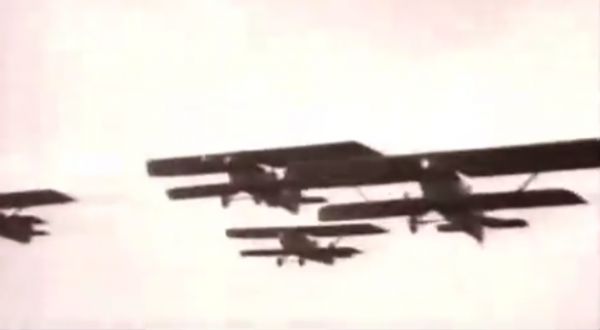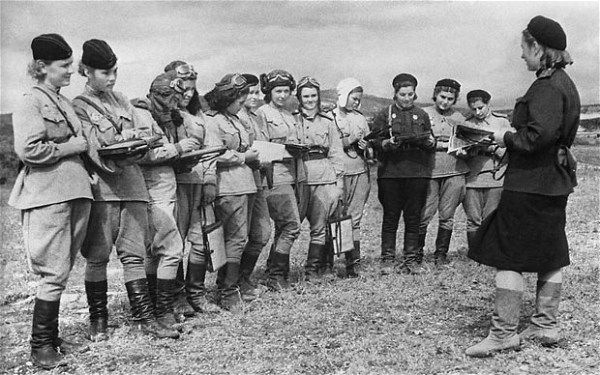Young women terrified German units during World War II.
 IT HAPPENED ONE DARK NIGHT…
IT HAPPENED ONE DARK NIGHT…
Imagine
you’re a German soldier, fighting your way deep into the Soviet Union
during the summer of 1942. During the time you’re not actually on the
front lines, you feel pretty safe and get a chance to rest, let down
your guard, even sleep a full night without constant vigilance. After
all, the Soviet army is retreating fast, and you’re just 19 miles from
Moscow.
Still, you can’t relax completely. There have been whispered rumors of
nachthexen,
“night witches” who fly silently after dark and drop bombs into
previously safe areas, destroying military targets and fraying nerves.
You don’t completely believe it, but like a lot of rumors, you wonder if
there’s likely some grain of a truth.
Then, while on guard duty
one night, you hear a rustling sound above, almost like wind through a
broomstick. Before you can investigate, the darkness lights up with a
blinding flash and a deafening explosion. The Night Witches have struck
again!
TOIL AND TROUBLE

By
1942, the Soviet armed forces were reeling. Millions of men had been
killed defending their homeland, often with antique rifles and
inadequate defenses. Three million more had been taken prisoner. What to
do? Well, there were always the women. Already working in fields and
factories, some Soviet women were recruited as pilots, mechanics,
navigators, and officers of a new all-female unit, the 588th Night
Bomber Regiment. They were assigned to hit specific German military
targets and to scare its forces with unpredictable, random attacks.
Some in the Soviet air force was resistant to the idea. The
“bomber” planes that the women were given to do the job seemed absurdly
inadequate: obsolete biplanes made in 1928 of wood and canvas and
designed for crop dusting and training. Each plane could carry only two
220-pound bombs. And they were slow— with a top speed of 97 mph— and so
flammable that they could ignite if hit by flares or tracer bullets. The
planes’ tiny engines were also noisy and tended to stall easily,
requiring the pilot to climb out and turn the propeller by hand to get
it started again. And because they flew so low, the women weren’t issued
parachutes, which just added weight and wouldn’t open in time anyway.
And radios? Forget about it. The women navigated in the dark using a
map, penlight, compass, and stopwatch to figure out where they were.
WITCHY WOMEN

The
female flyers, all between the ages of 17 and 26, turned most of these
serious drawbacks into virtues. Their top speed was slower than the
stall speed of German fighters, so if the female pilots maneuvered into
sudden dives or tight turns, the little planes were hard to shoot down.
Their low-altitude and wood-and-canvas construction also didn’t normally
make a blip on radar. And the women’s skill at restarting their planes’
noisy little engines inspired the best tactic they could use against
German antiaircraft defenses: The women would increase altitude until
they came close to their well-defended targets, and then cut their
engines and glide, making little noise beyond a light rustling until
they released their payload. As the bombs exploded, the pilot would
restart the engine and hightail it out of there, just barely above the
Germans on the ground. And so the “Night Witches” became a nickname that
the 588th borrowed proudly from their enemy.
BURN THE WITCH!

German
fighter pilots mostly gave up trying to catch the Night Witches, but
ground troops redoubled their efforts. The flimsy Russian planes often
came back riddled with bullets from ground fire. (After a particularly
harrowing raid, one pilot counted 42 new bullet holes in her plane.) The
Germans also developed a new tactic, setting up a circle of hidden
antiaircraft guns and spotlights around likely targets. Knowing that the
Witches flew in two-plane formations, the spotlight operators tracked
them across the sky while the antiaircraft guns ripped the flimsy
aircraft into pieces.
In response, the 588th added a third plane
behind the other two. As soon as the spotlights hit the first planes,
they’d pretend to give up on bombing the target, splitting off in
opposite directions while the spotlight operators scrambled to follow
them. Meanwhile, the third plane glided in to deliver its load. At the
next two targets, they’d switch places until all three planes had
dropped their bombs.
From
1942 until the war’s end in 1945, the 40 two-person crews flew more
than 30,000 missions, sometimes as many as 18 in a single night. By the
end of the war, they’d dropped 23,000 tons of bombs. Twenty-three of the
Witches earned the Hero of the Soviet Union medal (the highest honor
available), and about 30 died in combat.



No comments:
Post a Comment